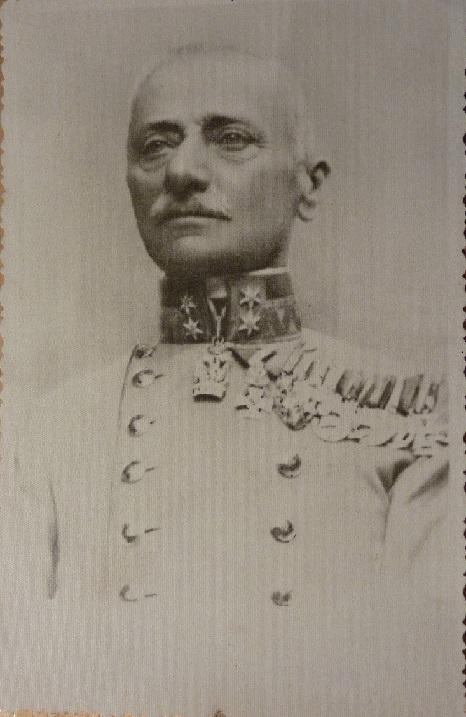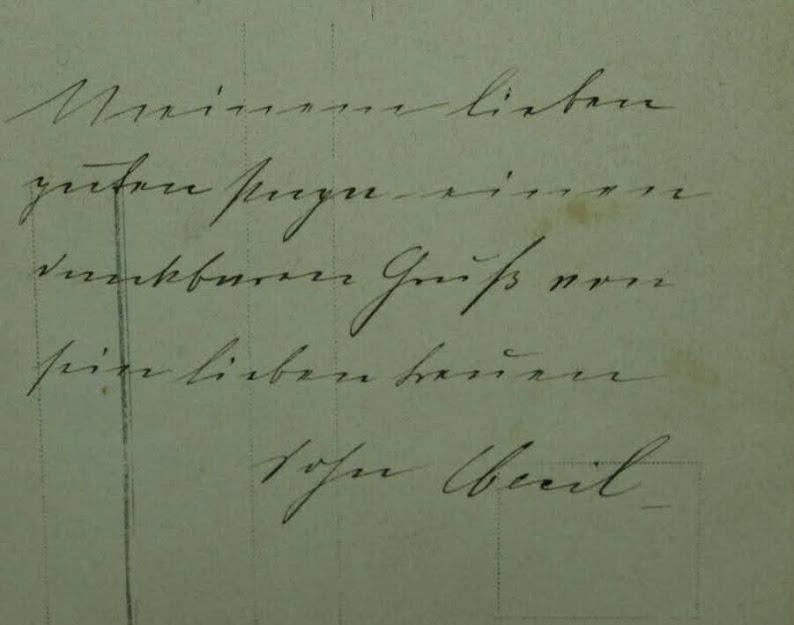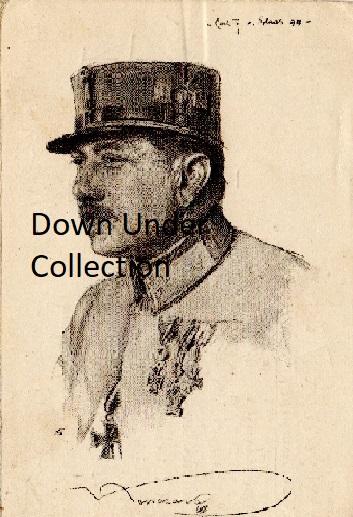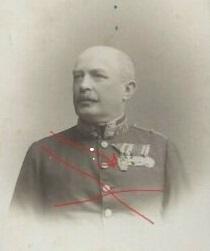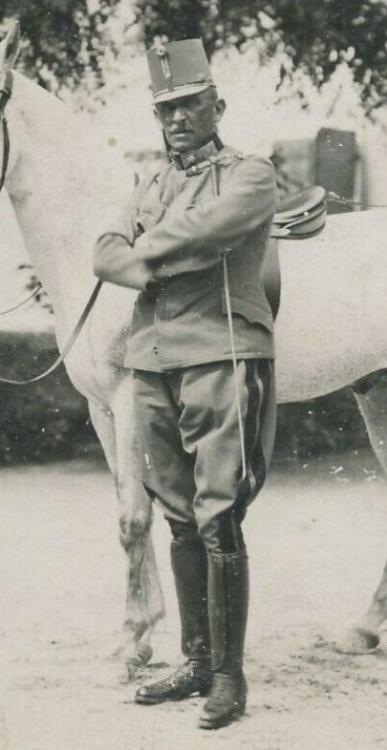-
Posts
419 -
Joined
-
Last visited
-
Days Won
3
Content Type
Profiles
Forums
Blogs
Gallery
Events
Store
Everything posted by Ian
-
Dear members, I have had the attached photo for a number of years and thought (wrongly as it turns out) that I had posted it on the GMIC forum previously. I had not. My FML has what I feel are a unique set of Orders ans decorations for identification purposes. I and a couple of other people I have showed it to thought it was FML Georg Komma, but after I received a copy of Balla Tibor's great book on Austro-Hungarian Feldmarschalleutnants it turns out that my photo and the photo Tibor has produced in his book are nothing alike. Hmm! back to the drawing board. I have trawled through the 1914 -1918 rank lists in the hope of identifying my man, but not one that I can see matches his awards exactly. One of the closet is Generalmajor Nikolaus Karapansca Edler von Kraina. The awards as best I can make out are for my mystery FML are: EKO-2, LO-R, FJO-R (peace time ribbon), MVK-3 (KD), MVK-3, Kreigsmedaille or an STM 1, D2/D3, Wound Medal or Bosnian Medal, JM 98, JK 08, MK 13 and an EK II (happy to be corrected) Does anyone recognise my mystery FML. Regards, Ian
-
Graham, I am 99% certain it is the Austrian Merit Cross with crown, but I would venture that the ribbon is correct. The anomaly you allude to is just the way the camera has picked up the weave on the ribbon. A mid level diplomat/Public official I suspect. Hopefully some one can decipher the French inscription. Regards, Ian
-
The cockade doesn't look right for a Austrian 1st republic one. They tended to be quite distinctive in the red/white/red and this one appears to be a roundel typical of Germany. The leather legging are not what I associate with Austria, although they are probably 'private' purchase and of course they would vary. So the jury is out on that item. My money (if I had any) would be on Wiemar period. I have seen the armband or something very similar on another forum a looong time ago, but I can't remember where.
-
I have looked, but I can't see a double headed eagle. That doesn't mean that it isn't, just that I can't see it. The shield on the eagles chest is more indicative of a German badge than an Austrian one. This is an interesting post and I hope we crack the mystery.
-
Yes the cockade does seem to be on the large side, but I still think German. Perhaps a private chauffeur 'enlistef' for the duration and out fitted by his boss? Pure speculation of course.
-
I think he is a chauffeur for a State Minister or some other state function. To me it is a German Chauffeurs uniform, not Austro-Hungarian. Also note the cockade on the cap, saying Prussian/German.
-
Tony, A very nice collection indeed.
-
Thank you one and all for your invaluable input to the issue. Whilst the jury is divided I am reasonably comfortable with Großpapa. Regards, Ian
-
Unfortunately, other than the greeting there is nothing else written on the reverse. Now that I know that the first part is Gruss,,,, I can see it, but the remainder is a blur. Originally when I first looked at it I thought it was Graf......
-
My initial thought was he was an Artillery officer, but cavalry is just as probable. I could not get a clear enough enlargement to be certain. This one is definitely a signature and it belongs to a Generalmajor...any idea?
-
Many thanks for your response. No wonder I could not find him?
-
Bayern, Thanks for the response. I can not find a Grunberger in Schmidt-Brentano's list of Generals. I am 99% certain that who ever he is he is a Feldmarschalleutnant.
-
-
Exactly what I was referring to. Although, I would go as to say that the pieces being worn are probably modified from the original badges and are of a 'solid' construction as opposed to the normal 'pressed' kapenabzeichen. This would be so that they to provide a little more weight when being worn as shown. Ian
-
Andreas, I suggest that they are not medals, bur rather a version of a 'kappenabzeichen' mounted on ribbons. First one looks very much like 1. Armee Christmas 1914 badge, and the second one looks similar, but so far unidentified. Regards, Ian
-
Simius, No worries. Ian
-
Simius, I have no issue with you saying I am wrong, but you are ignoring historical fact. There were regiments within the k.u.k. Army that were designated as 'Hungarian' and wore the uniforms as described by Bayern. I think you have confused the k.u. Honved with the regiments of the k.u.k. army. Regiments designated as ‘Hungarian’ within the common or k.u.k. Army were as follows: IR 2, IR 5, IR 6, IR 12, IR 16, IR 19, IR 23, IR 25, IR 26 IR 29, IR 31, IR 32, IR 33, IR 34, IR 37, IR 38, IR 39, IR 43, IR 44, IR 46, IR 48, IR 50, IR 51, IR 52, IR 53, IR 60, IR 62, IR 63, IR 64, IR 65, IR 66, IR 68 IR 69, IR 70, IR 71, IR 72, IR 76, IR 78, IR 79, IR 82, IR 83, IR 85, IR 86, IR 96, & IR 101. Regarding the Tizesedes, you are correct, and that was my error. but I stand by my original post regarding that the soldier has braid around the edge of his collar and he is the Hungarian equivalent of a Feldwedel – Törzsörmester. The fact remains that the k.u. Gendarmerie did not wear the ‘bear claw’ on their lower sleeves. So, I stand by my original comment that the Feldwebel in the photo is a common or k.u.k. Regiment soldier and not a k.u. Gendarmerie. When I wrote “The Royal Hungarian Gendarmerie had simple plain cuffs (no adornments)“ I was referring to the ‘bear claw’ and not the service chevrons. I could have been clearer, and again my bad. Regards, Ian
-
I am under the impression that the Hungarian regiments of the k.u.k. army wore the 'bear claw' on the cuff of their respective jackets. The bear claw was either silver or gold and matched the buttons on their jackets. The soldier in the photo appears to have braid along the bottom edge of his collar, and if so, this would indicate that he is a Feldwebel (Hungarian - Tizedes). NCOs who voluntarily increased their length of service wore a gold chevron 6 cm wide on the left cuff of their jacket. They then added thinner chevrons (approx 1.3 cm) for 3, 6 and 9 years of service respectively. The Royal Hungarian Gendarmerie had simple plain cuffs (no adornments). Regards, Ian
-
Graham, Very nice set of awards. I particularly like the 1st Class (Ehrenzeichen für Verdienste um des Rote Kreuz {EZ1-RK(KD)}); magnificent! Regards, Ian
-
Gentlemen, Thankyou for your responses. Rauch can be 'safely' ruled out as there is no Rauch mentioned in Schmidt-Brentano's work on Austro-Hungarian Generals. I have compared the photo to both Maximilian Lauer (not promoted to Generalmajor) and Viktor Bauer (later Feldmarschalleutnant) to my mystery GM and neither matches IMHO. I have tentatively settled on Ludwig Bauer as the most likely candidate, but to date, I have not seen any conclusive evidence to support my hypotheses.
-
Excellent, and thank you.



